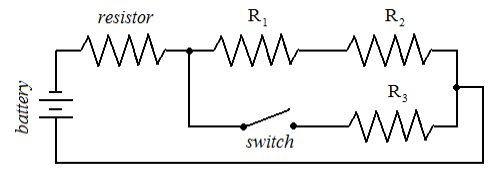Resistors
Objectives
- Understand how to measure resistance
- Measure resistances in series
- Apply logic to determine circuit configuration inside a box
Resources
- Multimeter
- Several resistors
- Wires with alligator clips
- Boxes with connection jacks, switches, and resistors hidden inside
Background
A basic circuit element is the resistor. A resistor quite literally resists the flow of current. Wires themselves have some small resistance, but this is usually negligible compared to that of the resistors in the circuit. Putting multiple resistors in series increases the resistance, effectively adding the resistances together. Unlike a battery, resistors do not have polarity – the resistance is the same if electricity flows in either direction.
Circuit diagrams are a generally-accepted way of drawing electrical circuits that clearly shows the arrangement of the components and the path or paths that electricity can follow. Symbols for a few types of components are shown below. Wires connecting components are just lines. If several wires meet in a junction, this is shown with a dot. Sometimes wires cross each other in a circuit and are not connected; in this case no dot is shown.
